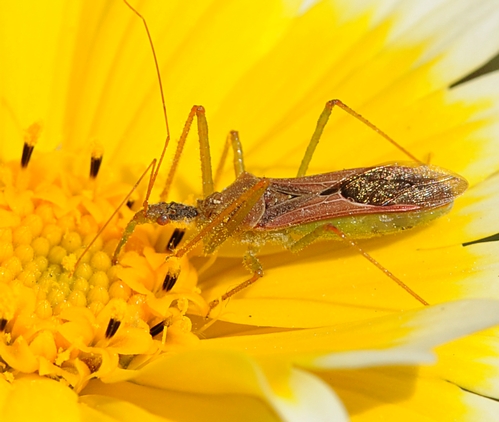- Author: Kathy Keatley Garvey
Ever seen assassination attempts in your garden?
They are not pretty if you're the prey. Neither are the successful attempts.
Take the Zelus renardii, aka the leafhopper assassin bug.
They've been hanging out in our nectarine tree, cosmos, passionflower vine and Cleveland sage. They stalk or lie in wait and then jab their prey with their long rostrum, injecting a lethal saliva. Next: they suck out the contents. They "assassinate" such pests as aphids, leafhoppers, and caterpillars of the cabbage white butterfly.
Assassin bugs also feed on beneficial insects, too, such as bees, lacewings and lady beetles, aka ladybugs.
They're often confused with kissing bugs. Can "assassin bugs can carry Chagas disease, which can transmit to humans?" a reader asked.
We asked noted entomologist Lynn Kimsey, director of the Bohart Museum of Entomology and professor of entomology at UC Davis, for comment and clarification.
"Assassin bugs and kissing bugs belong to the same family of insects, the Reduviidae," Kimsey said. "However, biologically they are very different. Kissing bugs belong to 20 or more species in the subfamily Triatominae. They are nocturnal blood feeders, and you almost never see them during the day. Most of these species in California are infected with the protozoan that causes Chagas disease, but because of differences in how they feed, few if any can actually transmit it to humans."
"The pathogen is transmitted in their droppings and have to be inhaled or scratched into the skin," Kimsey pointed out. "This only happens if the kissing bug defecates during feeding. The California species do not defecate until they leave the host and go back to a resting site, so the chances of getting Chagas disease from a bug in California are cosmically small. The assassin bugs you see during the day belong to an entirely different group of reduviids. They are all predators on other insects. Some of them, like the common garden assassin bug Zelus, are irritable biters but they do not transmit any kind of pathogen to anything."
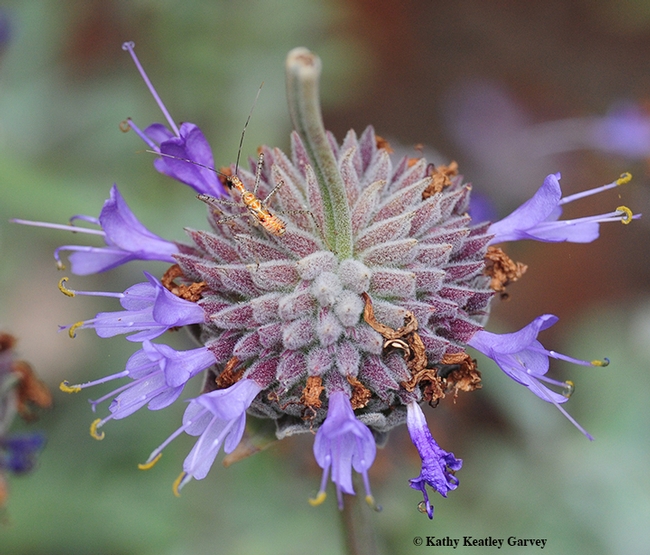
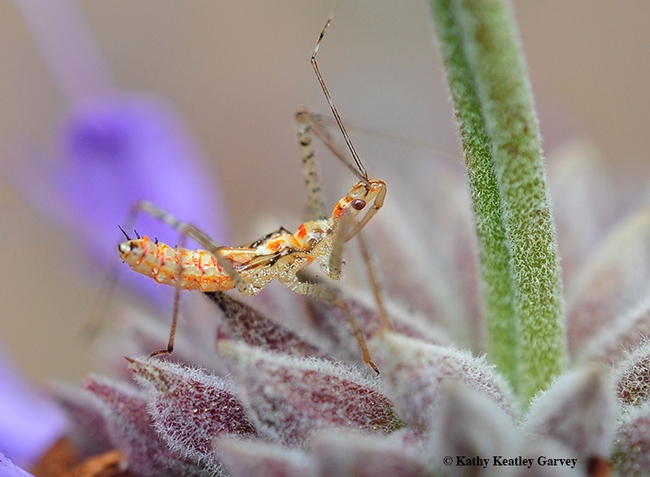
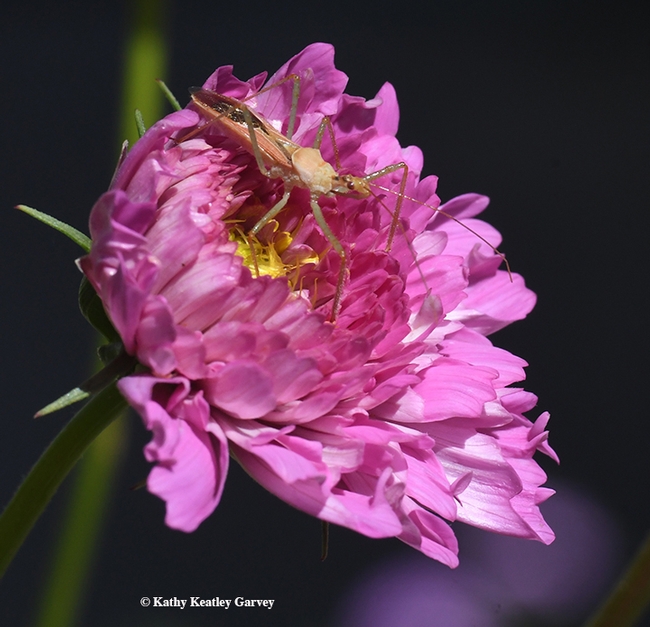
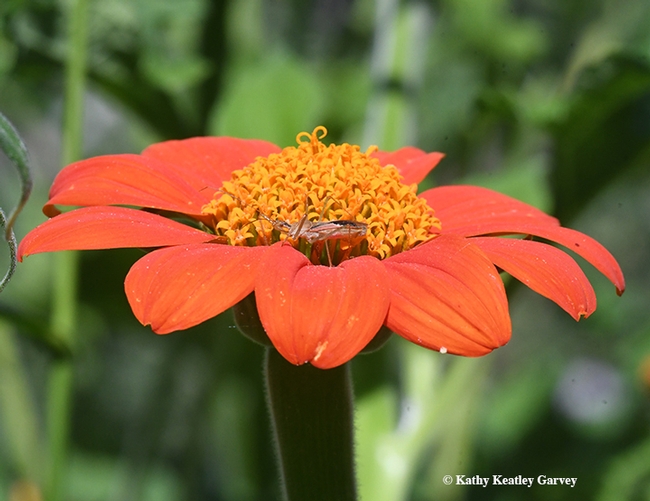
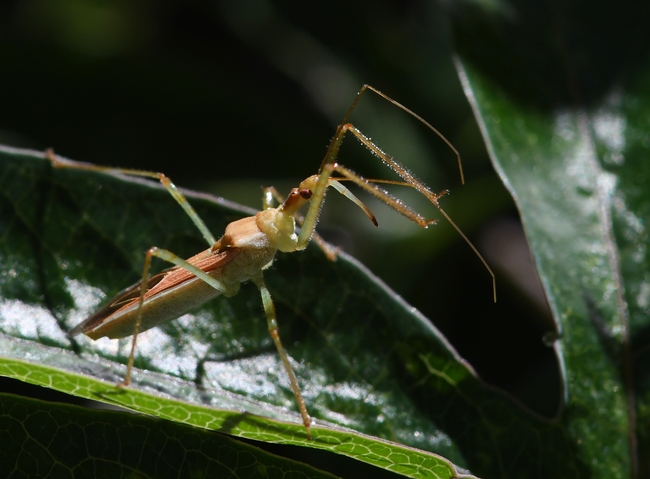
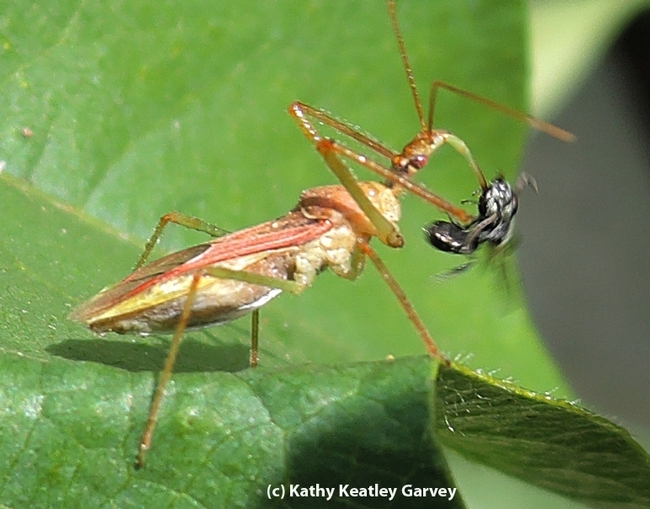
- Author: Kathy Keatley Garvey
There I was, walking across the University of California, Davis, campus to the Environmental Sciences Building for an agricultural communicators' meeting: a notebook in my hand, cell phone in my pocket, and my trusty pocket camera strapped around my neck.
Sometimes it's good not to lug around a 10-pound camera. Not this time, however.
Right inside the soybean planter box, I saw it--an assassin bug spearing what looked like a bee.
This was a predator-prey encounter between the assassin, Zelus renardii, and a bee, which native pollinator specialist Robbin Thorp, emeritus professor of entomology at UC Davis and an instructor of The Bee Course, identified as a male metallic sweat bee, Lasioglossum (Dialictus) sp., possibly L. tegulariforme.
I aimed the tiny camera and grabbed a couple of images before the predator, with prey attached, crawled beneath a soybean leaf.
Assassin bug are predators and don't distinguish between beneficial insects and pests. Still, we like them in our garden because they eat a lot of soft-bodied insect pests like aphids and leafhoppers.
Speaking of eating insects...the UC Davis Honey and Pollination Center is sponsoring a "Bugs and Beer" event on Saturday, Nov. 1 in the Robert Mondavi Institute for Wine and Food Science. It promises to be a cricket-kölsch kind of affair.
Beer expert Charlie Bamforth, Anheuser-Busch Endowed Professor of Malting and Brewing Sciences at UC Davis, will lead a joint tasting with celebrity bug chef David George Gordon, author of "The Eat-a-Bug" cookbook.
Bamford, known as "The Pope of Foam," is an icon around campus and the beer-brewing world. He's considered one of the country's most intriguing professors, noted Amina Harris, director of the Honey and Pollination Center. And David George Gordon--a fellow with three first names? He's been featured in the Wall Street Journal, Time magazine, and the National Georgraphic Kids.
Registration opened Monday (http://www.rmi.ucdavis.edu/events). Tickets are $50, general admission, and $25 for students. And, of course, "Bugs and Beer" is open only to those 21 and over because beer will be served.
We don't know what kind of bugs Gordon will serve, but they probably won't be assassin bugs. Bees, maybe. Specifically, maybe that "Three-Bee Salad?" on his website?
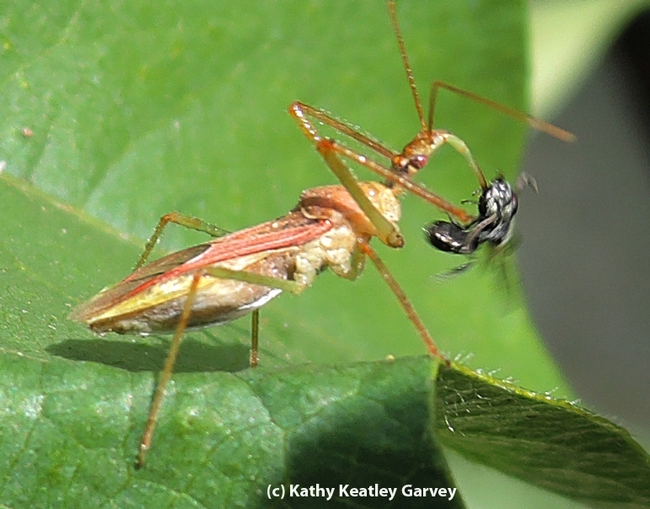

- Author: Kathy Keatley Garvey

Or more precisely, dead fruit flies or carrion on a tarweed plant can benefit the plant in more ways that most people would ever think about, say researchers in the UC Davis Department of Entomology.
Just as human tourists can be good for the economy, ‘insect tourists” can be good for a plant.
When the hairs of a “sticky plant” trap small insects or “insect tourists,” the “tourist trap” provides food for other predators, thus becoming a defensive mechanism that spares the plant from increased herbivore damage. Other beneficial results include greater plant fitness and increased fruit production.
“We conducted a large, simple field experiment to test the hypothesis that plant-trapped insects could enhance indirect defense by increasing predator densities,” said ecologist Billy Krimmel, a graduate student in the Jay Rosenheim lab, who worked with fellow ecologist Ian Pearse of the Richard Karban lab. Pearse is now a postdoctoral fellow in Walter Koenig’s laboratory at Cornell University, Ithaca, N.Y.
“Sticky plants-- those producing resinous, oily or hooked trichomes (hairs)--often entrap small insects that land on them as they pass by,” Krimmel said. “This insect carrion functions as a type of plant-provided food for defense.”
“This is the first example of such a plant-provided food being captured from the external environment,” Krimmel said. “We coined the term 'tourist trap', referring to the sticky hairs that catch insect passers-by.”
In their research, “Sticky Plant Traps Insects to Enhance Indirect Defence,” published in the journal Ecology Letters, the ecologists revealed that the trapped insect tourists “increased the abundance of a suite of predators, decreased herbivory and increased plant fitness.”
Later the journal Nature focused on the Krimmel-Pearse research in its ecology section: "When Plants Run the Food Chain."

"We have known for a long time that carnivorous plants entrap insects for their own benefit,” Pearse said. “In our current study, we found that the entrapment of insects by plants might be even more important and general than previously thought."
Krimmel and Pearse conducted their research in the Stebbens Cold Canyon Reserve, a UC Davis Nature Reserve located in Solano County, near the outlet of Lake Berryessa. Their sticky plant was tarweed (Madia elegans), an annual flowering California native plant in the family Asteraceae. It generally flowers in mid to late summer, from approximately June through September.
At our study site, tarweed's major herbivore is the specialist caterpillar Heliothodes diminutiva, which feeds largely on plant reproductive organs and can completely sterilise its host plants,” they wrote. The adult owlet moth, Heliothodes diminutive, lays its eggs on the developing buds. The emerging caterpillars can quickly devour all the flowers and buds.
“The suite of predators commonly found on tarweed,” they wrote, “includes the assassin bug Pselliopus spinicollis, two stilt bugs Hoplinus echinatus and Jalysus wickhami, the green lynx spider Peucetia sp. and the crab spider Mecaphesa schlingeri. All can navigate tarweed's sticky surface.”
Krimmel and Pearse chose 82 tarweed plants for their experiment. They placed dead Drosophila fruit flies to half of them, five flies per week through the growing season, and then monitored all the plants throughout the growing season.
“Because tarweed is a small, annual plant, we were able to do full counts of arthropods on all plants each week, and measure lifetime fruit production by the plants, allowing us to relate our experimental treatment to plant lifetime fitness,” the authors wrote.
“The addition of 5 dead fruit flies (carrion) to plants each week over the growing season increased the abundance of all surveyed predatory arthropods associated with M. elegans plants by 76 percent to 450 percent,. For P. spinoicollis, the most abundant predator, this effect was strongest during the early growth season in June and July.”
Specifically, “the addition of carrion (fruit flies) to M. elegans plants produced a 60 percent decrease in bud damage caused by H. diminutiva, the dominant lepidopteran herbivore in this system and increased lifetime fruit production by 10 percent,” the researchers said.
Jay Rosenheim's USDA research grant helped fund the project. Krimmel received two other grants: a National Science Foundation/Graduate Research Fellowship and a Jastro-Shields Research Scholarship.
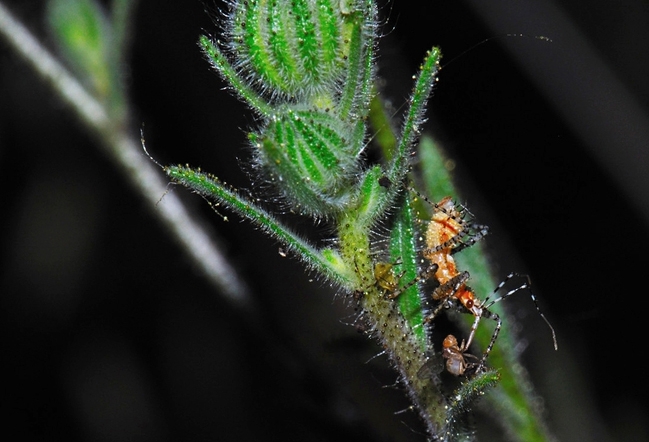

- Author: Kathy Keatley Garvey
It wasn't much of a fight.
The assassin bug scored a TKO.
Here's what happened: an assassin bug ambushed a spotted cucumber beetle in the Häagen-Dazs Honey Bee Haven at the Harry H. Laidlaw Jr. Honey Bee Research Faciility on Bee Biology Road, UC Davis.
It was "good guy vs. bad guy."
It was "beneficial insect vs. major agricultural pest."
The assassin bug (Zelus renardii) is a force to be reckoned with, especially when it comes to a spotted cucumber beetle (Diabrotica undecimpunctata).
The assassin bug wears no white hat but it should. A cunning predator, it lies in wait and stabs an unsuspecting prey with a lethal toxin powerful enough to paralyze and dissolve tissue.
Then it's all over but the feeding.
The assassin bug sort of looks like a cartoon character, with its beady eyes, long beak (proboscis) and its long, slender antennae.
The spotted cucumber beetle looks a little like a ladybug (aka lady beetle) except for its coloration. It's a 12-spotted greenish-yellow insect. And a pest. Diabrotica dines on young, tender plants like cucumbers, squash, pumpkins and melons (cucurbits). It also transmits a virus.
So it was the good guy vs. the bad guy. Zelus vs. Diabrotica.
This time the good guy won.
That loud cheering sound you hear is from all the melon growers out there.
Gotcha!
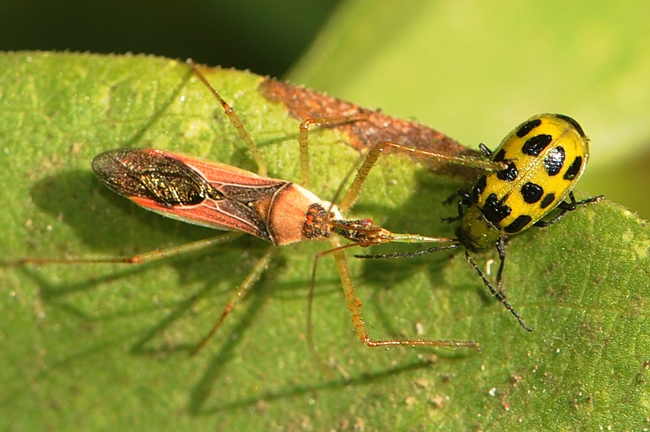
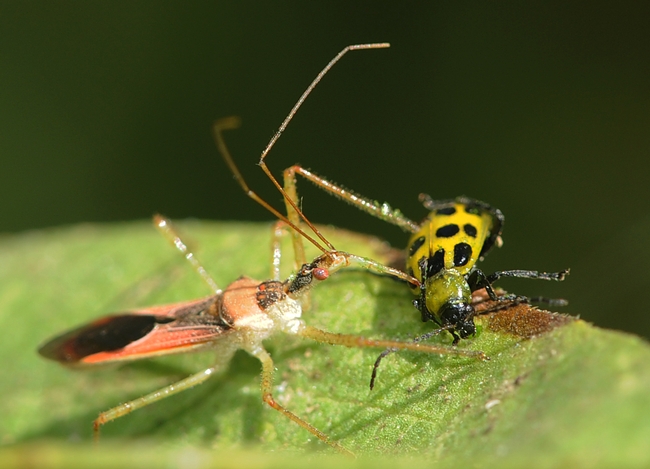
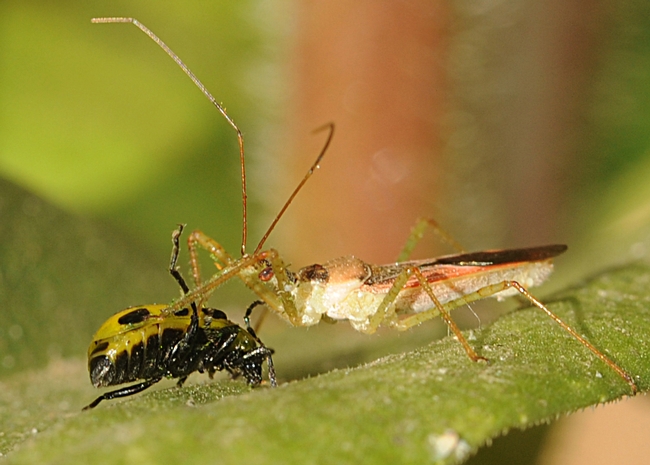
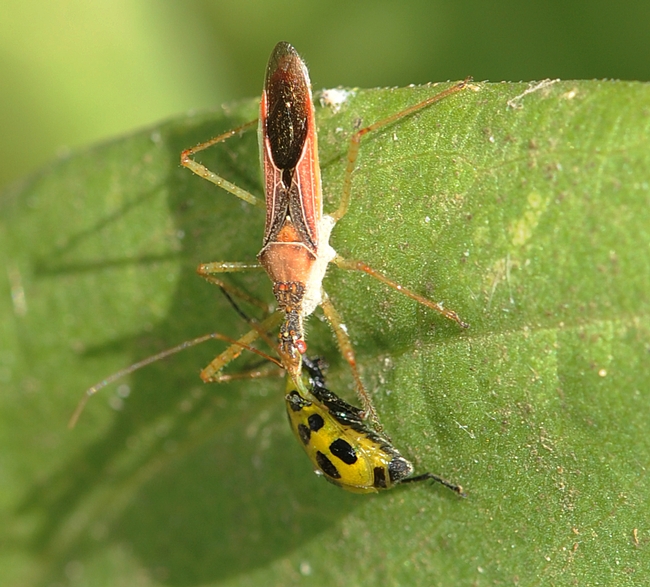
- Author: Kathy Keatley Garvey
If you see a patch of California native wildflowers known as "Tidy Tips," look closely.
The yellow daisylike flower with white petals (Layia platyglossa) may yield a surprise visitor.
You may see an assassin.
An assassin bug.
A member of the family Reduviidae, this is a long-legged, beady-eyed beneficial insect that stalks its prey and snatches it with its forelegs, somewhat like a praying mantis. It conquers its victim with a squirt of deadly venom from its beak (the collective term for its piercing, sucking mouthparts).
Once it has immobilized its prey, the assassin sucks the bodily contents, like a milkshake slurped through a straw.
The critter below is a assassin bug from the genus, Zelus, according to Lynn Kimsey, director of the Bohart Museum of Entomology and professor and vice chair of the UC Davis Department of Entomology.
The name, Zelus, originates from Greco-Roman mythology. Zelus, a winged enforcer, guarded the throne of Zeus.The assassin bug, true to its name, ambushes, attacks and captures other insects, such as aphids, flies, crickets, mosquitoes, beetles, caterpillars and "sometimes a hapless bee," said Bohart senior museum scientist Steve Heydon.
One thing about the Zelus assassin bug--it does not fly very fast. In fact, it totally ignored the camera poked close to its protruding eyes.The camera neither looked like or acted like a predator or prey.
No worries.


